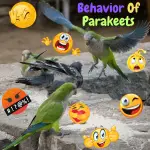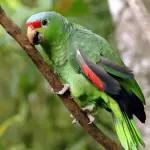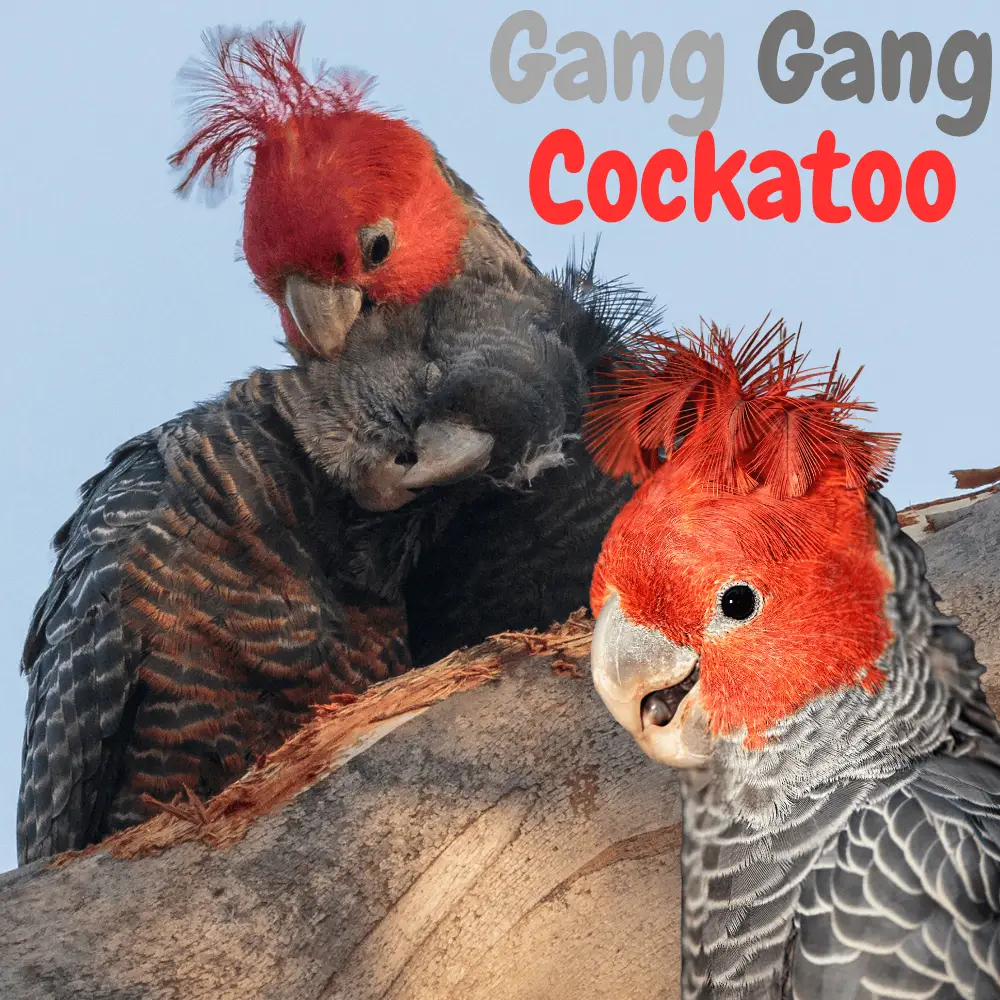
Gang Gang Cockatoo: In southwestern Australia, from Portland in Victoria to the Blue Mountains in New South Wales, there is a cockatoo that does not represent the standard image of it. There is here the biotope of a cockatoo with a very particular image, the red-headed cockatoo or Gang Gang.
Red-headed Cockatoo
Editor’s note: the Dutch name of this cockatoo is “Helm kaketoe” whose literal translation is a helmeted cockatoo.
This bird is better known here as the helmeted cockatoo but the names of red-headed cockatoos or its English name cockatoo Gang Gang are also used. The photos speak for themselves but it is such a tasty bird to describe and here is a description.
The red-headed cockatoo is a small, large cockatoo with large, broad wings, a short tail, and a hairy hoopoe tilted forward. This hoopoe which is raised forward which is in the air in the form of a loop has a fixed position and cannot be raised as in other cockatoos.
In adult males, the head and hoopoe have a striking bright red color and the rest of the body is dark gray. The adult female has a dark grey head and the hoopoe and breast feathers delimited with orange and yellow. By this difference in color, the difference between the two sexes is clearly visible.
In both sexes, the feathers of the body and wings have a light gray scaly effect, the additional yellow feathers in the female further amplify this effect. Adult birds have light beige beaks while young birds have dark gray beaks and otherwise resemble the adult female.
Young males are already recognizable by the mix of small red feathers on the head; After 3 years they have their adult plumage and after 4 to 5 years they are sexually adults. Red-headed cockatoos are pleasant, rather calm, and silent cockatoos that can be spotted in the trees where they feed by the peels of falling seeds or by the sounds they emit that lie between the sound emitted by the opening of a creaky door and the sound of a bottle of wine whose cap is removed.
Red headed cockatoo
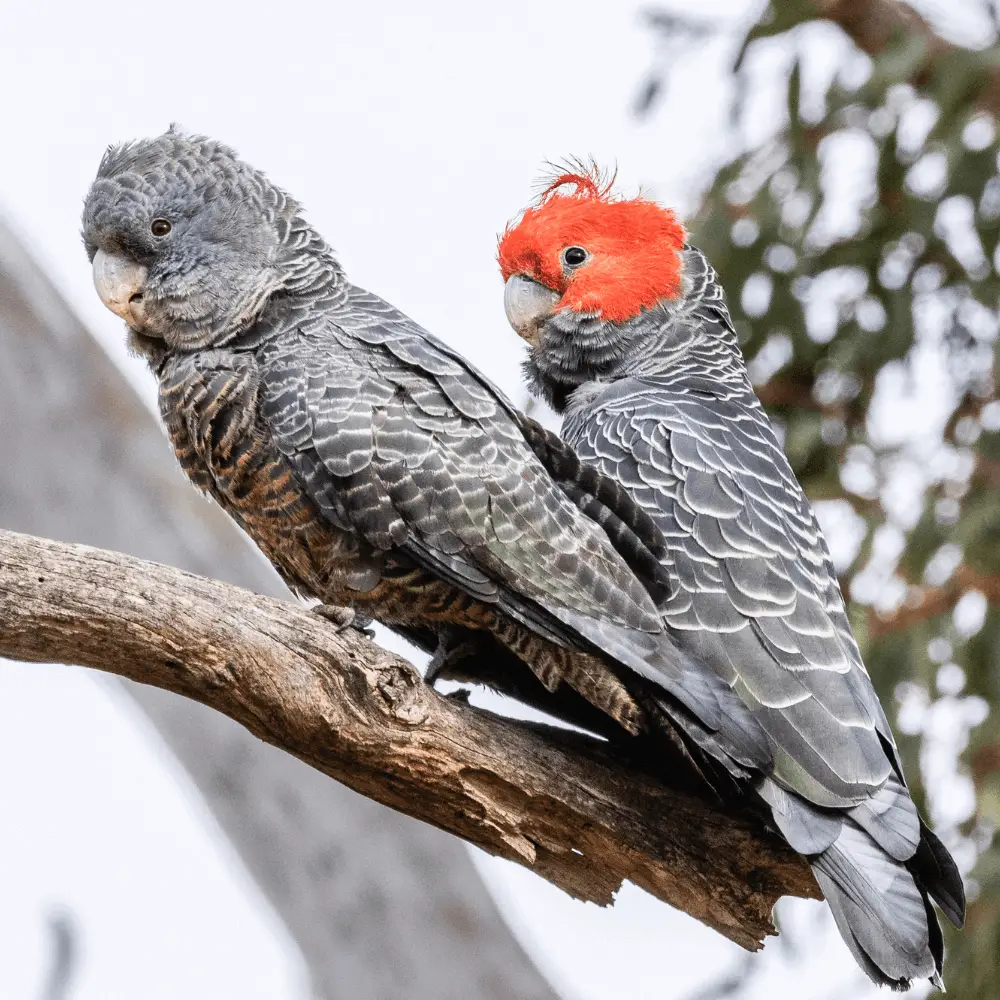
Gang Gang Cockatoo distribution and habitat
The Red-headed Cockatoo is endemic to south-eastern Australia and is found in large numbers in a relatively small range east of Nieuw Zuid Wales from the central hills on the south coast to the northern territories of Victoria and Seymour with some records east of Melbourne, the Mornington Peninsula and south-west Gippsland.
A separate population is found in the western part of Victoria in the Otway region bordering South Australia. Previously, until the mid-60s they were also found on King Island and Tasmania but now they are considered extinct.
They are sometimes still reported to occur during the breeding season in the northern coastal region of Tasmania. In the past, they have also been introduced to Kangaroo Island in southern Australia where there is now a small population. The estimated area of their territory varies depending on the season from 100,000 to 1,000.00 km².
The size of their population is not fixed exactly, but it is assumed that it is still suitable because this species is still present in large numbers in some parts of its habitat. Similarly, there is not yet a decrease in the number of birds that has been determined, there is even evidence of an increase in the population in some parts of its territory so that this species is not yet placed on the IUCN Red List as threatened but as a species with the least concern.
Gang Gang Cockatoo food
Red-headed cockatoos undertake migratory movements, linked to seasons from high to low regions. During the summer it is found higher, in areas of vast mountainous forests and forests with bushy low vegetation. During the winter it is found lower in drier and more open forests and wooded areas. At times, it is also possible to meet them on the roadsides in parks and gardens, or near cities. Red-headed cockatoos feed mainly on the seeds of endemic and introduced trees and shrubs. Their preference is for eucalyptus and acacias.
The different small seeds of eucalyptus have a very hard shell so eating takes a very large part of their time and therefore of the day. The time they need to eat is therefore also a social activity.
In addition to this, they will also feed on berries, fruits, nuts but also insects, and their larvae. In winter, it will be mainly the berries of the Cotoneaster (loquat) and hawthorn that have been introduced that will be eaten with pleasure.
They eat mainly in trees and rarely come to the ground, in contrast to the rosaline cockatoo, which often only eats the fruits that have fallen or the ears of the pines. The need to drink of course drags them to the ground. During the breeding season, they will feed in pairs or small family groups. Outside this period usually in groups that can go up to 60 birds.
Red headed cockatoo
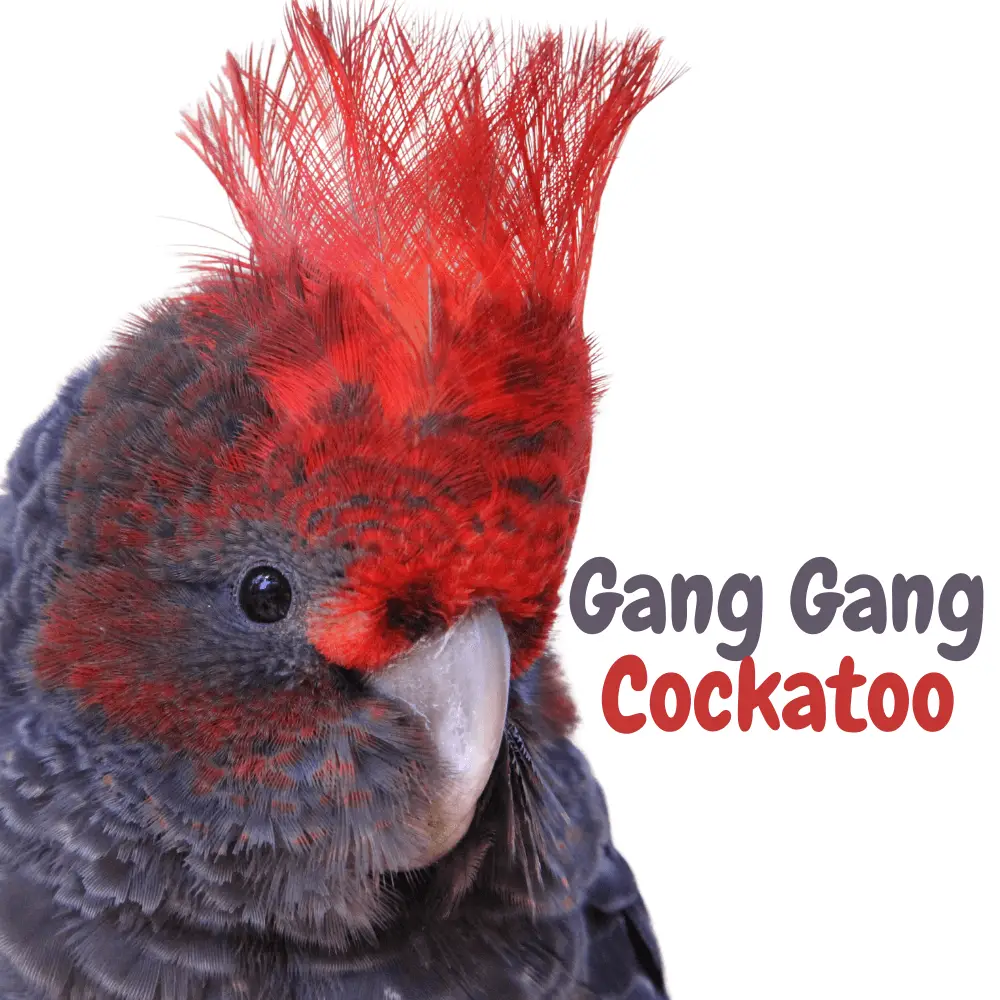
Red-headed Cockatoo Reproduction in the wild
Red-headed cockatoos form monogamous pairs that breed from October to January. The female will look for a hole where to nest usually high in a tree to lay her 2 but sometimes 3 eggs. The two birds will prepare the nest box together. They will line it with wood chips and sawdust by gnawing the sides of the inside of the hole.
The two birds will incubate +/- 20 to 25 days and then take care of the chicks that will leave the nest around 6 to 7 weeks. It will take another 4 to 6 weeks after that for both parents to take care of the chicks and during this period it is therefore possible to see family groups while they feed. In some cases, where different pairs have bred close to each other, nativity scenes may form, where different young may be perched together in the same tree while their parents feed them.
Red headed cockatoo
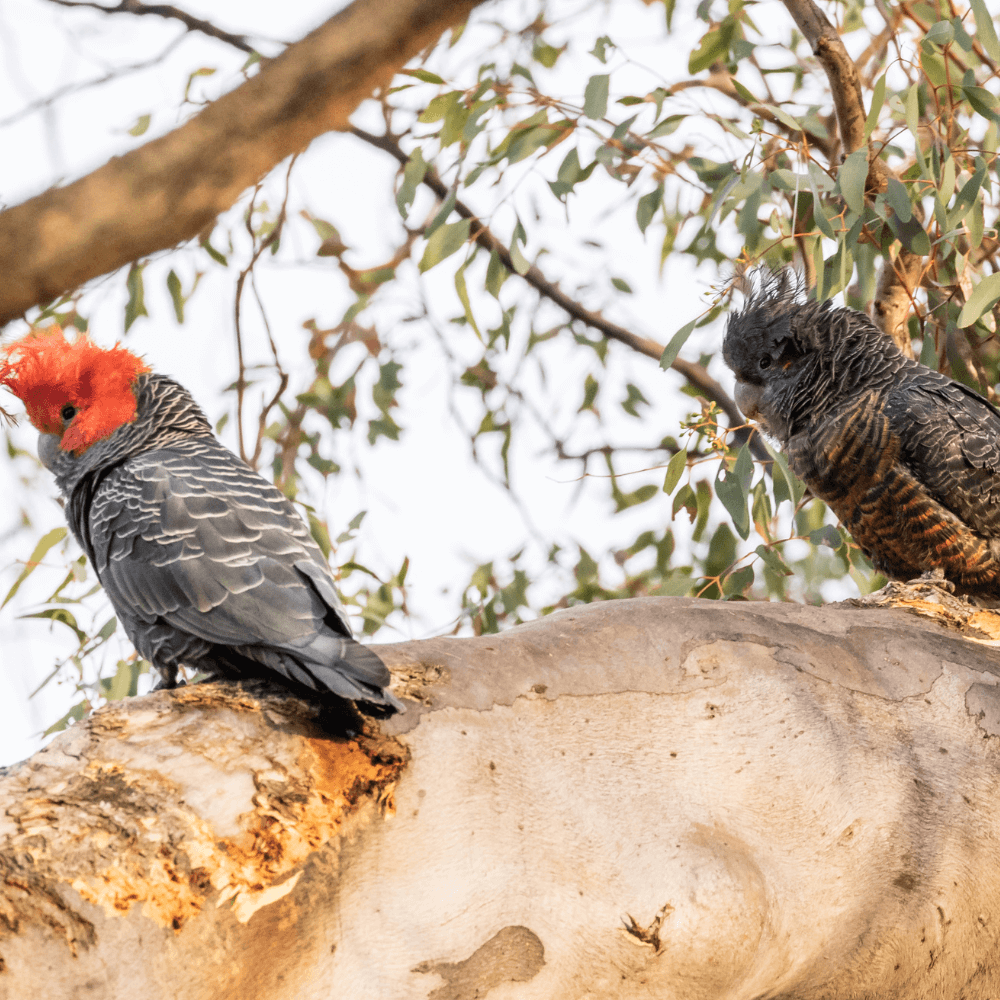
Red-headed Cockatoo breeding
The red-headed cockatoo is not held in large numbers among Australian amateurs. It should also be mentioned that where they are kept in warmer places in Australia, breeding successes are rarer. Here, the best results of captive breeding come from the cooler places in the country.
Here too, in Australia, they have a reputation for being picky in keeping and breeding and they have an unfortunate tendency to bite themselves. The causes of this phenomenon are still difficult to define but boredom and stress are recognized as the most well-known factors.
This stress is partly to be amputated by the many birds “caught” in the wild. Greater availability of captive-bred birds may, perhaps, change this situation in the future. To keep the birds in captivity busy and thus counter boredom and stress, they must be fed mostly with small seeds.
Sunflower seeds seem to be fatal to these birds and cause pecking problems. An essential necessity is also a constant supply of fresh willow branches or other available trees to avoid boredom and counter-pecking. Another cause could be that in their natural diet, there are specific nutritional materials in eucalyptus seeds that we can hardly give them.
If in their country of origin, there are not many amateurs who keep and breed with this cockatoo parrot, there are still several in Europe. However, they occur only sporadically in aviaries.
They need an aviary at least 5 m long, 1.2 m wide, and 2 m high. Since in nature, they do not eat on the ground, their feeders should be placed at a height of about 1-1.5 m above the ground. As a diet, they must be given a varied diet, consisting of different small seeds such as wheat, peeled oats, canary seeds, and millet as well as a wide variety of fresh vegetables and fruits of which the apple is their favorite.
The branches, seeds, and pines of acacia trees and other endemic shrubs can be presented to these birds. This will provide them with hours of physical activity and mental stimulation. This physical activity is necessary to help prevent bad pecking habits.
Fresh berries and seeds of these bushes can be frozen and thus given later. In the wild, the red-headed cockatoo will also feed on caterpillars, pupae, larvae, beetle larvae, and other insects that are found during the season. In aviaries, we can introduce them to “farmed” insects such as larvae, pupae, mealworm beetle, crickets, etc., as well as insects that can be found in our trees and gardens.
Some breeders feed their birds meat to fill the animal protein needs of their birds during the breeding season. Sometimes these animal proteins are given in the form of chicken, carbonade bones, or dog food. They are particularly fond of the berries of the Cotoneaster and hawthorn
(Crataegus monogyna). There is also mention of couples who had a problem with calcium absorption and the added addition of calcium to the drinking water may then be necessary.
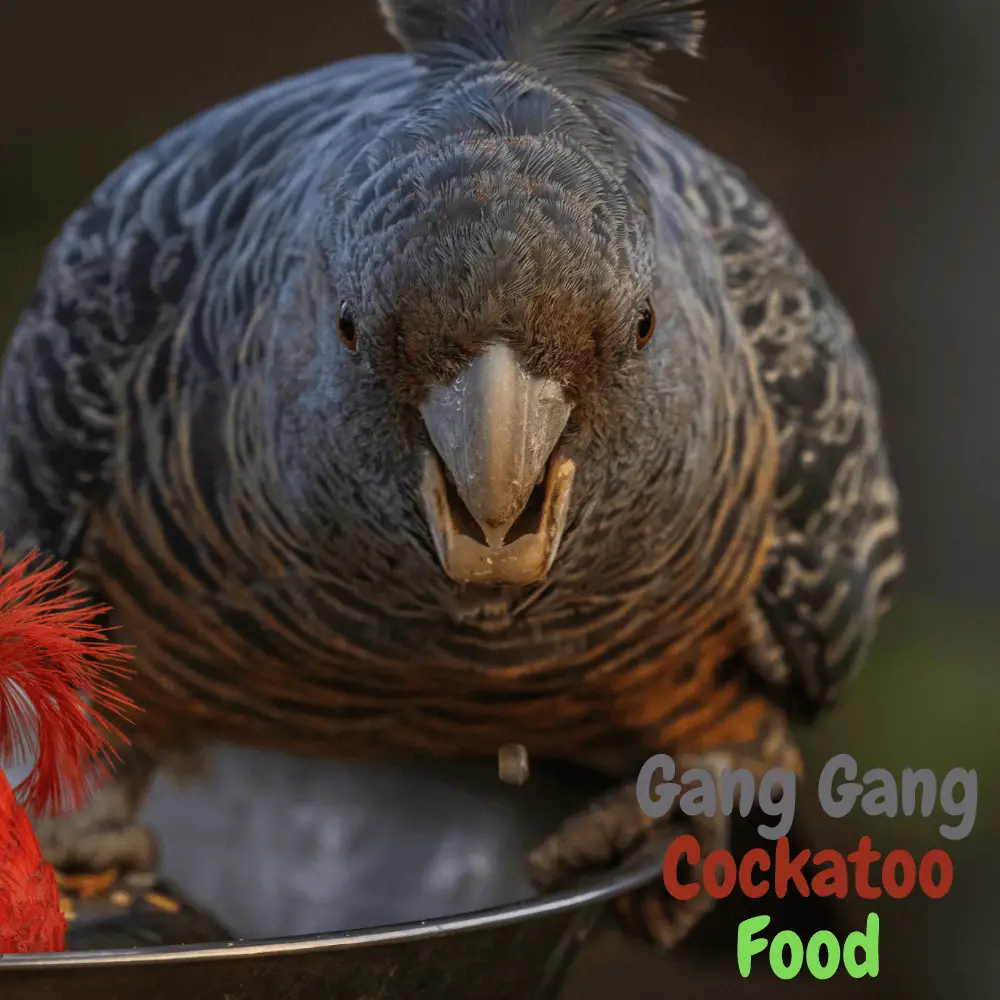
It is recommended to present them with a nest box with a depth of one meter but the dimensions of the nest box itself can strongly differentiate and are often influenced by the preference of the owner of the birds. The preference of birds can be influenced by the size and type of nest box in which the bird itself was incubated and bred.
If space permits, the presentation of different types and sizes of nest boxes, placed in different places in the aviary allows birds to make their own choice. As soon as a couple has made their choice, the other nest boxes can be removed. In captivity, during the breeding season, they can sometimes be very aggressive towards their keeper and they are very sensitive to nest box controls.
This is often not tolerated and can lead to them abandoning their young or cannibalism. In Europe, too, there are already breeding results, so more young birds of their own breeding are presented for sale and therefore it is likely that some of the problems mentioned above will disappear.
Red-headed cockatoos are by nature magnificent pet birds when they have been raised by hand but with such a low number of birds among amateurs, it is imperative that all birds that have been bred are found in a breeding program to ensure their survival in poultry farming.
The Loro Parque in Tenerife has different pairs of these magnificent birds and they have already obtained several breeding results with these birds.
Gang Gang Cockatoo protection
Although it is not on the IUCN Red List, past data still give us information that we must be very economical with this species. For this reason, this species is also protected by Australian laws. The survival of the Red-headed Cockatoo is adversely influenced, according to this Act, by habitat loss through the rehabilitation and cutting of mature trees that possess potential nesting holes. The loss of nesting places has a negative effect on the population composed of about 20,000 specimens.
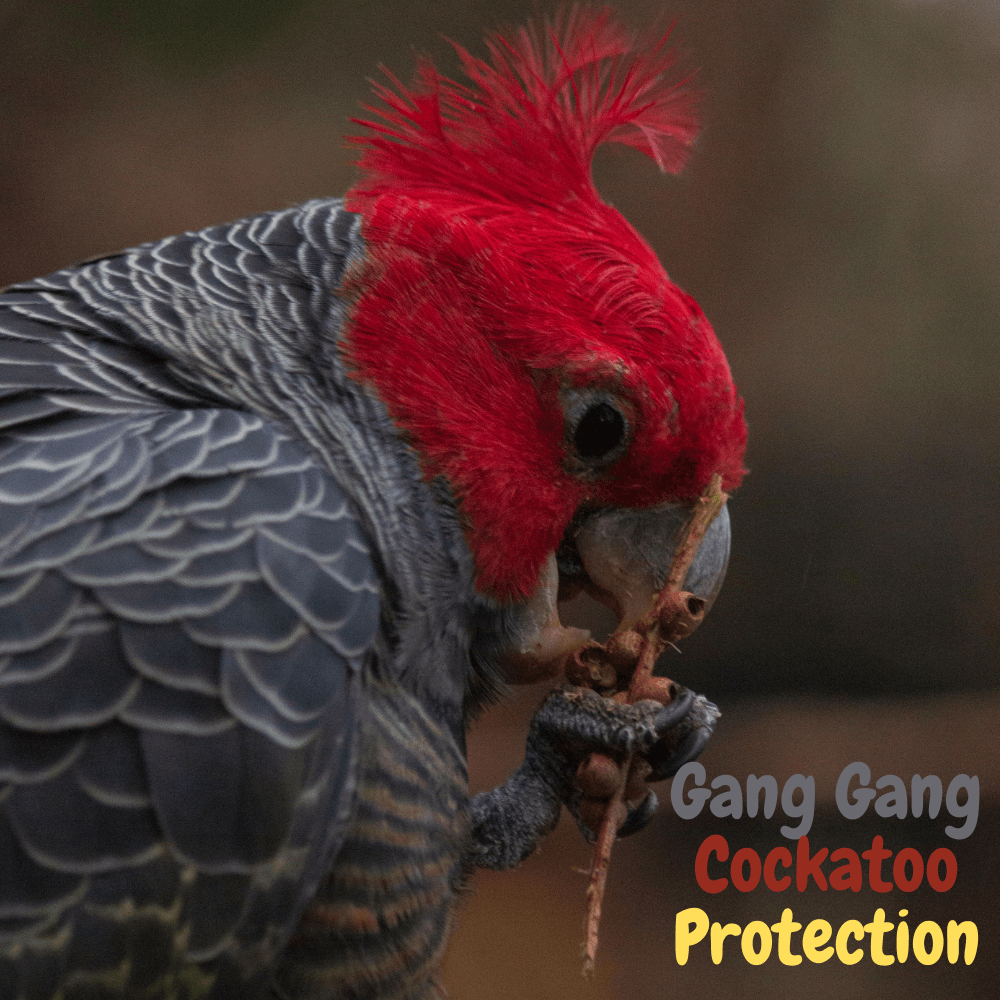
Data from the Australian Bird Atlas clearly show that the number of red-headed cockatoos has declined dramatically over time. These show us that between 1977 and 2001, the population in New South Wales decreased by 44%.
In organic regions, the decrease is to be shared separately; the Australian Alps at 49%, hills southwest of New South Wales at 67%, around Sydney at 57%, the southeastern tip at 44%, and the upper southeastern regions at 22%. It is only possible to enter an increase in 2 regions; the north coast of New South Wales 69% and Nandewar 420%.
The numbers entered are considered very reliable because the red-headed cockatoo is considered an easily identifiable bird in nature. One population that is currently most threatened is that of Lane Cove Valley in New South Wales.
Already from the arrival of the first Europeans in Australia, their numbers have only decreased and now the largest concentration of red-headed cockatoos takes place in the southeast of the country. In this place, they show no fear for humans and it is sometimes possible to approach and admire them very closely.
Red-headed cockatoos are the size of a medium-sized cockatoo, i.e. +/- about 35 cm the size of a rosaline cockatoo. By this size, it is the smallest of the dark-colored cockatoos.
However, recent DNA tests have shown that they are more closely related to white and pink cockatoos than to the large black cockatoos found in Australia.
Another threat is Psittacine Cirovirus disease (PCD). The Red-headed Cockatoo is susceptible to this disease and is found mainly in the Bowral area in the upper regions south of New South Wales. This disease is spread via infected nesting sites and thus forms a potential threat to species.
Taking into account the above, the Scientific Committee is of the opinion that the future of the red-headed cockatoo will be very threatened in New South Wales unless circumstances and factors change drastically or the evolutionary development of birds can stop this threat.
Gang-gang Cockatoo Talkative
SOURCE: Cyan Chester Parrots

